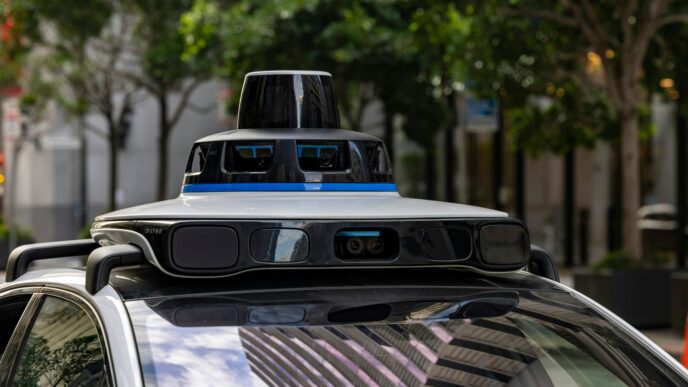Artificial Intelligence (AI) is changing the way we defend against cyber threats. As hackers become more advanced, using AI in cybersecurity is essential for protecting sensitive information and systems. This article explores how AI can help organizations detect threats, automate security processes, and stay ahead of cybercriminals. We’ll look at the benefits, challenges, and future trends of AI in cyber defense.
Key Takeaways
- AI is crucial for identifying and stopping cyber threats quickly.
- Automating security tasks can reduce human error and improve efficiency.
- AI helps organizations predict and prepare for future cyber attacks.
- Collaboration and sharing information between organizations enhance defense strategies.
- Training and awareness are key for effective AI-driven cybersecurity.
The Role of AI in Cyber Defense

Understanding AI in Cybersecurity
Artificial Intelligence (AI) is becoming a key player in cybersecurity. It helps organizations detect and respond to threats faster than ever. By analyzing large amounts of data, AI can spot unusual activities that might indicate a cyberattack. This ability to learn from data makes AI essential in the fight against cyber threats.
Importance of AI for Cyber Defense
AI is crucial for several reasons:
- Speed: AI can analyze data in real-time, allowing for quick responses to threats.
- Efficiency: It automates many security tasks, freeing up human resources for more complex issues.
- Adaptability: AI systems can learn and adapt to new threats, making them more effective over time.
Challenges in Implementing AI
Despite its benefits, using AI in cybersecurity comes with challenges:
- Data Quality: AI needs high-quality data to function effectively.
- Complexity: Setting up AI systems can be complicated and costly.
- Trust: Organizations must trust AI decisions, which can be difficult if the system is not transparent.
In the world of cybersecurity, embracing AI is not just an option; it’s a necessity to stay ahead of evolving threats.
AI is transforming how we approach cyber defense, making it more proactive and efficient. As threats continue to grow, the role of AI will only become more significant.
AI-Powered Threat Detection and Analysis
Real-Time Threat Detection
AI plays a crucial role in real-time threat detection. By analyzing large amounts of data quickly, AI can spot unusual activities that might indicate a cyber threat. For example, AI tools can help identify:
- Brute-force attacks where hackers try many passwords.
- Phishing attempts that trick users into giving away personal information.
- Malware infections that can spread through networks.
Analyzing Anomalous Activities
AI systems are designed to learn from normal behavior patterns. This means they can easily spot when something is off. For instance, if a user suddenly logs in from a different country, AI can flag this as suspicious. Here are some key points:
- AI can analyze user behavior to find anomalies.
- It helps in identifying zero-day attacks, which are new and unknown threats.
- AI can adapt and improve its detection methods over time.
Machine Learning for Threat Analysis
Machine learning is a type of AI that helps systems learn from data. This is important for threat analysis because:
- It allows AI to recognize patterns in data that humans might miss.
- It can predict potential threats based on past incidents.
- AI can continuously update its knowledge to stay ahead of new threats.
In the world of cybersecurity, using AI for threat detection is not just an option; it’s a necessity. Organizations must adapt to these technologies to protect their data and systems effectively.
By leveraging AI, businesses can enhance their security measures and respond to threats more efficiently. This proactive approach is essential in today’s digital landscape, where cyber threats are constantly evolving.
Automating Security Operations with AI
Automated Incident Response
AI can significantly enhance the speed and efficiency of incident response. By automating the analysis of security events, AI systems can quickly identify the nature and extent of a security incident. This reduces the time it takes to respond, allowing security teams to focus on more complex issues. Key benefits include:
- Faster detection of threats
- Reduced workload for security teams
- Improved accuracy in identifying incidents
Streamlining Security Tasks
Automation helps streamline various security tasks, making them more efficient. For example, AI can:
- Onboard data sources automatically.
- Correlate alerts from different systems.
- Enrich security details for better analysis.
This not only saves time but also allows teams to allocate resources to more strategic activities.
Reducing Human Error in Cyber Defense
Human error is a common vulnerability in cybersecurity. By automating processes, organizations can minimize these risks. AI systems can:
- Eliminate manual tasks that are prone to mistakes.
- Enhance decision-making by providing data-driven insights.
- Reallocate human resources to critical areas needing attention.
Automating security operations with AI is essential for organizations to keep up with the increasing sophistication of cyber threats. It allows for a more proactive approach to cybersecurity, ensuring that defenses are always ready to respond to new challenges.
Proactive Threat Intelligence Using AI
Predictive Analytics for Cybersecurity
AI plays a crucial role in predictive analytics, helping organizations anticipate potential cyber threats before they occur. By analyzing historical data and identifying patterns, AI can forecast possible attack vectors and vulnerabilities. This proactive approach allows security teams to strengthen defenses and mitigate risks effectively.
Leveraging Adversarial AI
Adversarial AI is a powerful tool in the fight against cyber threats. It involves using AI to simulate attacks, helping organizations understand how adversaries might exploit weaknesses. This knowledge enables teams to develop better defenses and stay ahead of potential threats.
Staying Ahead of Emerging Threats
To remain secure, organizations must continuously adapt to new threats. AI can help by:
- Monitoring real-time data for unusual activities.
- Analyzing trends in cyberattacks to identify emerging threats.
- Updating security protocols based on the latest intelligence.
By utilizing AI for proactive threat intelligence, organizations can significantly reduce their risk of falling victim to cyberattacks. This approach not only enhances security but also builds resilience against future threats.
AI in Network Security
Implementing Zero-Trust Security
Zero-trust security is a strategy that assumes no one, whether inside or outside the network, can be trusted by default. This approach requires strict verification for every user and device trying to access resources. By using AI, organizations can automate the verification process, ensuring that only authorized users gain access to sensitive data.
AI for Network Traffic Analysis
AI plays a crucial role in analyzing network traffic. It can:
- Detect unusual patterns that may indicate a cyber threat.
- Monitor data flow in real-time to identify potential breaches.
- Help in understanding the normal behavior of users and devices, making it easier to spot anomalies.
Policy Creation and Enforcement
Creating and enforcing security policies can be time-consuming. AI can simplify this by:
- Learning from existing network traffic to recommend effective policies.
- Automatically updating policies based on new threats.
- Reducing the manual effort required to maintain security protocols.
In the world of cybersecurity, AI is essential for staying ahead of threats. It helps organizations adapt quickly to new challenges and enhances overall security posture.
By leveraging AI in network security, organizations can better protect themselves against evolving cyber threats and ensure a more secure environment for their operations.
Behavioral Analytics for Cyber Defense
Identifying Evolving Threats
Behavioral analytics helps organizations spot changing threats by analyzing user and device activities. This method goes beyond traditional security measures, which often rely on known attack patterns. Instead, it focuses on understanding normal behavior to detect unusual actions that could signal a potential attack.
Enhancing Threat-Hunting Processes
Using AI, businesses can improve their threat-hunting efforts. Here are some key benefits:
- Real-time monitoring of user and device activities.
- Creation of behavioral profiles for applications and users.
- Ability to analyze large amounts of data quickly to find anomalies.
Developing AI-Based Profiles
AI models can create profiles based on typical behavior patterns. This allows organizations to:
- Detect anomalous activities that deviate from established norms.
- Respond faster to potential threats by identifying them early.
- Continuously update profiles as new data comes in, ensuring they remain relevant.
By leveraging behavioral analytics, organizations can significantly enhance their cyber defense strategies, making it harder for attackers to succeed.
| Feature | Benefit |
|---|---|
| Real-time monitoring | Immediate threat detection |
| Behavioral profiling | Customized security measures |
| Continuous learning | Adaptation to new threats |
AI-Driven Cybersecurity Solutions
User and Entity Behavior Analytics (UEBA)
AI technologies like User and Entity Behavior Analytics (UEBA) help organizations monitor the activities of users and devices. By analyzing patterns, these systems can spot unusual behavior that might signal a zero-day attack. This proactive approach allows businesses to defend against threats they might not even know exist yet.
AI for Zero-Day Attack Prevention
AI plays a crucial role in preventing zero-day attacks. These attacks exploit vulnerabilities that are not yet known to the software developers. By using machine learning, AI can identify and block these threats before they cause harm. This capability is essential for maintaining a strong security posture in today’s digital landscape.
Protecting Against Unknown Vulnerabilities
AI systems are designed to adapt and learn from new data. This means they can help protect against unknown vulnerabilities by continuously analyzing network traffic and user behavior. Here are some key benefits of using AI for this purpose:
- Real-time monitoring of network activities.
- Automated responses to suspicious actions.
- Continuous learning to improve threat detection.
In the fight against cyber threats, leveraging AI is not just an option; it’s a necessity. Organizations must embrace these technologies to stay ahead of potential attacks.
By integrating AI-driven solutions into their cybersecurity strategies, organizations can enhance their defenses and better protect their sensitive information from evolving threats.
Future Trends in AI and Cyber Defense
Evolving AI Technologies
The future of AI in cybersecurity is bright, with new technologies emerging to tackle advanced threats. Organizations must stay updated on these advancements to effectively protect their systems.
Adapting to AI-Driven Threats
As cybercriminals become more sophisticated, they will increasingly use AI in their attacks. This means that organizations need to adapt their defenses accordingly. Here are some key strategies:
- Invest in AI-powered solutions that can evolve with threats.
- Collaborate with industry peers to share insights and intelligence.
- Educate employees about the risks associated with AI-driven attacks.
Innovations in AI for Cybersecurity
Innovation is crucial for staying ahead of cyber threats. Organizations should focus on:
- Implementing predictive analytics to foresee potential attacks.
- Utilizing machine learning for real-time threat detection.
- Developing robust AI systems that can learn and adapt under pressure.
In the battle against cyber threats, embracing AI is not just about keeping up; it’s about staying one step ahead. Organizations must prioritize AI integration to enhance their defenses and protect sensitive data.
By focusing on these future trends, organizations can build a more resilient cybersecurity posture against evolving threats.
Building Resilient AI Systems for Cyber Defense

Ensuring Robustness of AI Systems
To effectively combat cyber threats, it is crucial to ensure the robustness of AI systems. This involves:
- Building security into the design process of machine learning (ML) systems.
- Promoting diversity and redundancy in AI systems to enhance resilience.
- Managing risks across the ML and cybersecurity ecosystem.
Balancing Accuracy and Security
Finding the right balance between accuracy and security is essential. Here are some strategies:
- Implement continuous learning mechanisms that adapt to new threats.
- Set thresholds for critical security settings to limit the impact of vulnerabilities.
- Use both ML and non-ML tools to offset risks effectively.
Continuous Learning Under Pressure
AI systems must be able to learn continuously, even under pressure from attackers. This requires:
- Regular updates to training data to reflect evolving threats.
- Monitoring system performance to identify weaknesses.
- Engaging in proactive threat intelligence sharing to stay ahead of adversaries.
In the world of cyber defense, staying ahead of threats is not just an option; it’s a necessity. Organizations must invest in resilient AI systems to protect their assets effectively.
| Strategy | Description |
|---|---|
| Security in Design | Integrate security measures from the start. |
| System Diversity | Use varied systems to reduce single points of failure. |
| Continuous Learning | Adapt AI systems to new threats in real-time. |
Collaborative Defense Strategies with AI
In the fight against cyber threats, working together is key. Organizations can enhance their defenses by sharing information and resources. Here are some important strategies:
Sharing Threat Intelligence
- Collaboration among companies helps in identifying and responding to threats faster.
- Sharing data about attacks can lead to better understanding and prevention of future incidents.
- Establishing partnerships with other organizations can create a stronger defense network.
Industry Collaboration
- Joining forces with other businesses can lead to shared resources and knowledge.
- Participating in industry groups can help organizations stay updated on the latest threats and defenses.
- Collaborating on research can lead to innovative solutions to combat cyber threats.
Enhancing Collective Defense
- By pooling resources, organizations can invest in better security technologies.
- Collective defense strategies can help in creating a unified response to cyber incidents.
- Regular training and drills among partners can improve readiness against attacks.
In today’s digital world, no organization is an island. By working together, we can build a stronger defense against cyber threats and protect our valuable data.
Educating and Training for AI-Driven Cyber Defense
Raising Cybersecurity Awareness
To effectively combat cyber threats, organizations must prioritize cybersecurity awareness among all employees. This includes:
- Regular training sessions on identifying phishing attempts.
- Workshops on safe internet practices.
- Updates on the latest cyber threats and trends.
Training Security Teams
Security teams need specialized training to handle AI-driven tools. Key areas of focus should include:
- Understanding machine learning algorithms used in threat detection.
- Learning how to respond to AI-generated alerts.
- Developing skills in analyzing data patterns for anomalies.
Developing Best Practices
Establishing best practices is essential for maintaining a strong defense. Organizations should:
- Create a clear incident response plan.
- Regularly update security protocols based on new threats.
- Encourage collaboration between teams to share insights and strategies.
In the fight against cyber threats, education and training are not just beneficial; they are essential for building a resilient defense system. By investing in knowledge, organizations can empower their teams to effectively counter evolving threats.
Conclusion
In conclusion, using AI in cyber defense is essential for organizations today. As cyber threats become more advanced, AI helps in spotting and stopping attacks quickly. By investing in AI tools, sharing information with others, and teaching employees about online safety, companies can improve their security. The future will see even more AI in cybersecurity, making it crucial for businesses to stay updated on new technologies. Embracing AI is not just about keeping up; it’s about being ready to face the challenges of tomorrow’s cyber world.
Frequently Asked Questions
What is the role of AI in cybersecurity?
AI helps find and stop cyber threats faster. It can look at a lot of data quickly to spot unusual activities that might mean an attack.
Why is AI important for protecting against cyber threats?
AI can learn from data and improve over time. This makes it really good at identifying new types of cyber threats and defending against them.
What challenges do companies face when using AI for cybersecurity?
Companies might struggle with how to set up AI systems correctly. They also need to make sure these systems are safe from attacks.
How does AI detect threats in real-time?
AI tools can analyze data as it comes in, allowing them to find threats immediately instead of waiting.
Can AI help automate security tasks?
Yes, AI can take over many routine security tasks. This lets human security teams focus on more complicated issues.
What is predictive analytics in cybersecurity?
Predictive analytics uses AI to look at data and guess where future attacks might happen, helping to prevent them.
How does AI improve network security?
AI can help create better security rules and analyze network traffic to find issues or unusual behavior.
What is behavioral analytics in cybersecurity?
Behavioral analytics uses AI to understand how users and devices act. This helps find threats that change over time.













